Repairs can be a load of fun. Just let your imagination go. You may need to repair a goof you made, a defect nature provided, a nail hole in wood with “character”, or you might be creating your own character by inserting a repair where no defect originally existed. Drilling out a make-believe “worm hole” for example. Traditional techniques include Dutchmen and wooden plugs.
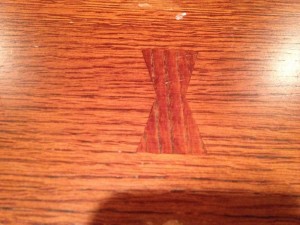
The Dutchman is a classic patch or repair, although sometimes it is placed symmetrically in a piece just for its beauty as an accent. The patch can be contrasting or matching.
The materials for the repairs can be chosen to hide the fix or highlight it. The site of the defect might be a good place for a Greene and Greene ebony plug.
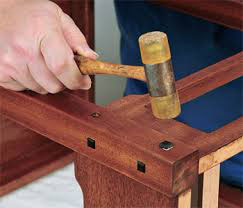
Ebony plugs, a la the Greene Brothers, aren’t so much a repair as an accent. Black plugs have become synonymous with their work.
Epoxy repairs can be a load of fun. You can take good old two-part epoxy and mix in the color ingredient of your choice. CLICK HERE to read how to make your epoxy syringes last as long as possible. One I’ve used several times is black concrete coloring. Whether you’re coloring concrete, stucco or epoxy, this stuff is powerful.
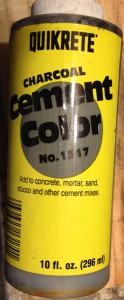
This bottle of concrete coloring will probably be handed down to my great-grandchildren. When they need to color something black in their woodworking 3-D printer, they can add just a little bit.
Some experimentation on scraps of wood similar to your project will give you the needed experience without putting your furniture at risk. Believe me when I say it doesn’t take much black powder to get the epoxy as dark as you want it! Start filling from the bottom of the defect and work to the top. Let some flow proud. Some porous species will let the color flow into the wood, another good reason to practice on scraps in case you don’t like that effect. Once cured, it sands easily, and can even be polished if you prefer to draw attention to the site. I rather liked the look after a few practice samples, so I incorporated it into Brenda’s bedside table project made from Hurricane Katrina-flooded, used oak flooring.
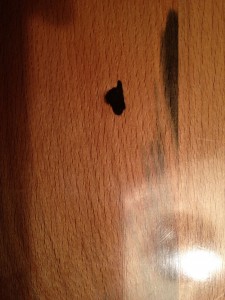
This is a closeup of one of the tops. It demonstrates an understated amount of seepage of color into surrounding wood fibers.
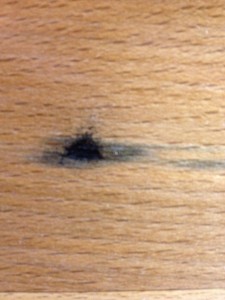
In another location the same species of oak, sawn with a different grain pattern, allowed substantial movement of color into surrounding wood fibers.
For a more subtle, but still structurally strong effect, you can mix dust from your sander’s exhaust into the epoxy. Depending on the size and shape of the opening, the repair might totally disappear.
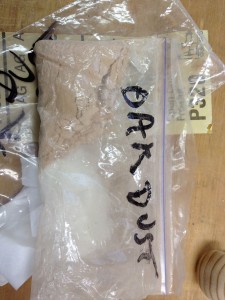
As I sanded (and sanded and sanded) this project, I used the random orbit sander’s bag to collect oak dust to use in this and future oak/epoxy repairs.
——-
Jim Randolph is a veterinarian in Long Beach, Mississippi. His earlier careers as lawn mower, dairy farmer, automobile mechanic, microwave communications electronics instructor and journeyman carpenter all influence his approach to woodworking. His favorite projects are furniture built for his wife, Brenda, and for their children and grandchildren. His and Brenda’s home, nicknamed Sticks-In-The-Mud, is built on pilings (sticks) near the wetlands (mud) on a bayou off Jourdan River. His shop is in the lower level of their home. Questions and comments on woodworking may be written below in the comments section. Questions about pet care should be directed to his blog on pet care, www.MyPetsDoctor.com. We regret that, because of high volume, not all inquiries can be answered personally.

